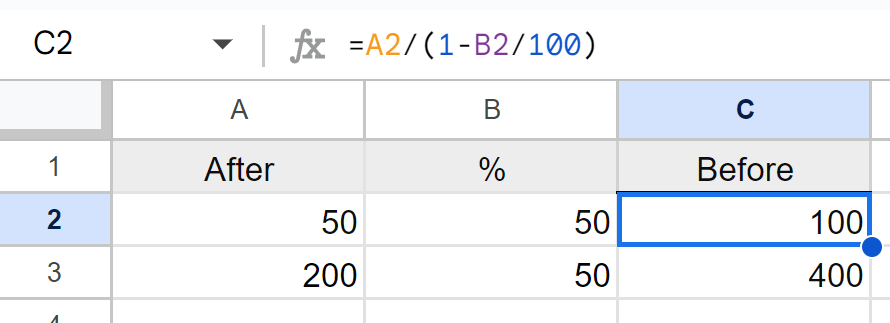Easily determine the number before a percentage decrease with our specialized online calculator, built for precision and simplicity. Whether you're handling financial projections, solving percentage-related problems, or comparing data, our tool is designed to make the process seamless. Skip the manual work and rely on our efficient calculator to save time and enhance accuracy.
To find the original number before a percentage decrease, you can reverse the calculation. Here's a step-by-step guide on how to do it.
Percentage decrease tells you how much the original number has been reduced by a certain percentage. For example, if a number decreases by 20%, you know that the final number is 80% of the original.
You need two numbers: the final number (after the decrease) and the percentage of decrease. For example:
Subtract the percentage decrease from 100 to get the percentage of the original number remaining. Then convert that percentage into a decimal. For example:
Percentage remaining = 100% - 20% = 80%
As a decimal: 80% = 0.80
To find the original number, divide the final number by the decimal from Step 3:
Original Number = Final Number / Decimal
For this example: Original Number = 80 / 0.80 = 100
You can verify the calculation by checking if the original number minus the percentage decrease gives you the final number:
Original Number - (20% of Original Number) = Final Number
100 - (20% of 100) = 80
Formula is =A2/(1-B2/100), where A2 is the "After" number, and B2 is the "Percentage".

Want to find the original number before a percentage decrease using Windows Calculator? Here's a step-by-step example. Let’s say you know the final value is 140 after a 30% decrease, and you want to find the original number.
Press , type , and press .
Type (the value after the decrease).
If something was decreased by 30%, that means 70% of the original remains.
After pressing , the Calculator will show , which is the original number before the 30% decrease.
Scenario: After a 25% discount, the price of a jacket is $75. What was the original price?
Calculation: Find the original price before a 25% decrease.
Let X be the original price. The discounted price is 75% of the original price.
$75 = X × (1 - 0.25)
$75 = X × 0.75
X = $75 / 0.75 = $100
Result: The original price of the jacket was $100.
Scenario: A meal costs $120 after including a 10% tax. What was the price before tax?
Calculation: Find the pre-tax price before a 10% increase.
Let X be the price before tax. The final price is 110% of the pre-tax price.
$120 = X × (1 + 0.10)
$120 = X × 1.10
X = $120 / 1.10 = $109.09
Result: The price before tax was approximately $109.09.
Scenario: Your salary after a 15% deduction is $2,550. What was your salary before the deduction?
Calculation: Find the salary before a 15% decrease.
Let X be the original salary. The current salary is 85% of the original salary.
$2,550 = X × (1 - 0.15)
$2,550 = X × 0.85
X = $2,550 / 0.85 = $3,000
Result: The salary before the deduction was $3,000.
Scenario: An asset is worth $700 after a 20% depreciation. What was its original value?
Calculation: Find the value before a 20% decrease.
Let X be the original value. The depreciated value is 80% of the original value.
$700 = X × (1 - 0.20)
$700 = X × 0.80
X = $700 / 0.80 = $875
Result: The value before depreciation was $875.
Scenario: A tuition fee of $900 is the result after a 12% discount. What was the original fee?
Calculation: Find the original tuition fee before a 12% decrease.
Let X be the original fee. The discounted fee is 88% of the original fee.
$900 = X × (1 - 0.12)
$900 = X × 0.88
X = $900 / 0.88 = $1,022.73
Result: The original tuition fee was approximately $1,022.73.
| Final Value | Percent Decrease (%) | Original Number |
|---|---|---|
| 70 | 30 | 100 |
| 85 | 15 | 100 |
| 90 | 10 | 100 |
| 140 | 20 | 175 |
| 160 | 25 | 213.33 |
| 50 | 50 | 100 |
| 45 | 55 | 100 |
| 30 | 70 | 100 |
| 120 | 10 | 133.33 |
| 180 | 40 | 300 |
| 200 | 20 | 250 |
| 75 | 25 | 100 |
| 60 | 40 | 100 |
| 110 | 10 | 122.22 |
| 95 | 5 | 100 |
| 180 | 10 | 200 |
| 135 | 10 | 150 |
| 55 | 45 | 100 |
| 48 | 52 | 100 |
| 90 | 25 | 120 |